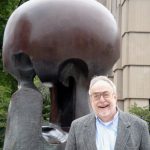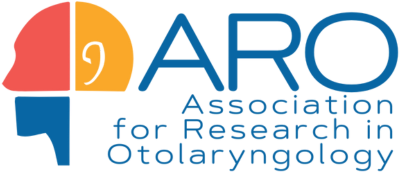Jay Goldberg, PhD
In Honor & Memory

Jay Goldberg, PhD
(1935-2019)
ARO Award of Merit, 1997
Jay M. Goldberg, Ph.D., age 83, passed away on Monday, June 17, 2019, in Chicago, IL.
Goldberg was a “powerhouse in neurophysiology,” according to his colleagues. He was, for decades, the leading authority on the vestibular system, which is essential for normal movement and equilibrium. His laboratory was the first to unravel a cluster of previously neglected sensory organs that feed crucial information about spatial orientation, motion, balance, and head position to the brain. “Our goal,” according to his website, “is to understand the operation of the entire system in terms of its cellular components. To this end, a combined neurophysiological, morphological and behavioral approach is used. The research program ranges from biophysical studies of the isolated sensory organs to single-unit recordings.”
Goldberg enjoyed a long and prolific career. He published more than 70 papers and 30 books, chapters and reviews, and is best known for his pioneering studies of inner-ear function that revealed how animals, including dogs and humans, pinpoint where sounds come from and how they are perceived. The first of these studies, led by Goldberg and Paul Brown, his postdoctoral fellow, focused on how binaural neurons in the ears of dogs respond to sound localization. In a landmark study, Goldberg and Brown discovered how binaural neurons in the superior olive nucleus (or hindbrain) allow an animal to localize sound left to right, proposing a computational mechanism, decades before the advent of the field of computational neuroscience. This groundbreaking study, published in the J. of Neurophysiology 50 years ago, remains the fourth most-cited paper in any APS journal.
In the early 1970s, Goldberg and the late Cesár Fernández, initiated a study into the vestibular compartment of the inner ear. They intended to complete the project within a year, but it took decades. It became their life’s work. Together, the two authors mapped out the structures that enable animals, from turtles to monkeys, to perceive their orientation in space. This second cluster of studies emphasized the simplicity and elegance of the authors’ analysis, their careful phrasing and reasoning, and the coherent picture that emerged by examining a pinball-like set of structures that respond to head movements.
The three groundbreaking studies, published in 1971, described the “first complete characterization of the physiology of the mammalian peripheral otolith system,” according to Dora Angelaki, PhD, professor of neuroscience at New York University, who praised their historic significance in 2005. “When combined, these papers constituted the seed for an explosion of quantitative studies on the properties of neurons in the central nervous system that detect and coordinate movement,” she wrote. These three papers “set the stage for vestibular system sensory function and launched a plethora of related quantitative studies during the decades to follow.”
“Goldberg and Fernández essentially figured out the vestibular system,” explained Peggy Mason, PhD, professor of neurobiology at UChicago, who was Goldberg's colleague for years. “They created the field of vestibular physiology, starting from nothing.” Goldberg was the chief editor of a new edition of a classic work on vestibular function, “The Vestibular System: A Sixth Sense”. He catalogued a wide range of phenomena controlled by the vestibular system, ranging from how dancers and spinning ice skaters maintain their balance to how alcohol intoxication leads to vertigo. His work opened up channels that explained “all sorts of unexpected results,” Mason added. He had a talent for making complicated ideas accessible, and he “wrote beautifully about what he and his colleagues discovered.” He was recruited to become a member of one of NASA’s Scientific Advisory Committees, working in the Vestibular Research Facility from 1984 to 1992, and he wrote the so-called “Goldberg Report,” setting out a strategic plan for life science research at NASA for the 1990s.
Born Nov. 9, 1935, Jay Myron Goldberg grew up on the West Side of Chicago. In 1952, at age 16, he entered University of Chicago. He graduated in 1956 with multiple honors in biochemistry, followed by four years in the biopsychology doctoral program. He then enrolled in a post-doctoral program in biopsychology at the University of Wisconsin-Madison, with funding from the National Science Foundation and the National Institutes of Health. Although his three years at Wisconsin made him a lifelong Green Bay Packers fan, Goldberg returned to Chicago in 1963 as an assistant professor of physiology. He stayed at UChicago for the rest of his career. He quickly rose through the ranks. He was promoted to associate professor in 1968 with a joint appointment in theoretical biology in 1969 and to professor in 1972. Mentored at different stages of his career by two ARO Award of Merit winners, Jerzy Rose and W. Dewey Neff, Goldberg won the Award of Merit himself in 1997.
He became a mentor to nearly everyone in the field.
He was a “larger-than-life character, ‘Mr. Vestibular,’ for four decades,” said Anna Lysakowski, PhD, professor of anatomy and cell biology at the University of Illinois at Chicago. “He became a mentor to nearly everyone in the field. He was critically insightful, with a lot of scientific integrity. People sometimes got nervous around him, but they appreciated his guidance.” Goldberg was deeply committed to research and teaching. “He was a true mentor for me,” recalled Mason. “He was unbelievably helpful, patient, generous and honest. He read every paper I wrote, every grant.” He could be gruff and was not a gentle editor, but “he wanted us to succeed. That was his way of being kind,” she added. “If you look at the leading vestibular researchers across the country and to some extent the world, most, if not all, are the scientific children or grandchildren of Dr. Jay M. Goldberg.”
Goldberg had four children from a previous marriage, David, Susan, Nancy, Aaron, and a stepson, Peter, from his marriage to Florence Bonnick, who died in July 2018. Besides his passion for sports, he and Florence also loved classical music and spent summer weeks in Santa Fe, New Mexico, enjoying the Santa Fe Opera and Santa Fe Chamber Music Festival.
A memorial service was held Oct. 17 on the University of Chicago campus at Bond Chapel.
Modified from an obituary written by John Easton for the University of Chicago website
Univ. of Chicago obituary: http://www.uchicagomedicine.org/forefront/biological-sciences-articles/2019/june/jay-goldberg-phd-pioneer-in-understanding-the-vestibular-system
Bárány Society obituary: http://barany2020.com/jay-goldberg-phd-pioneer-in-understanding-the-vestibular-system.php
